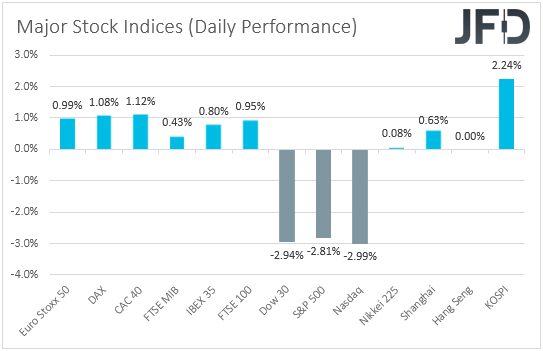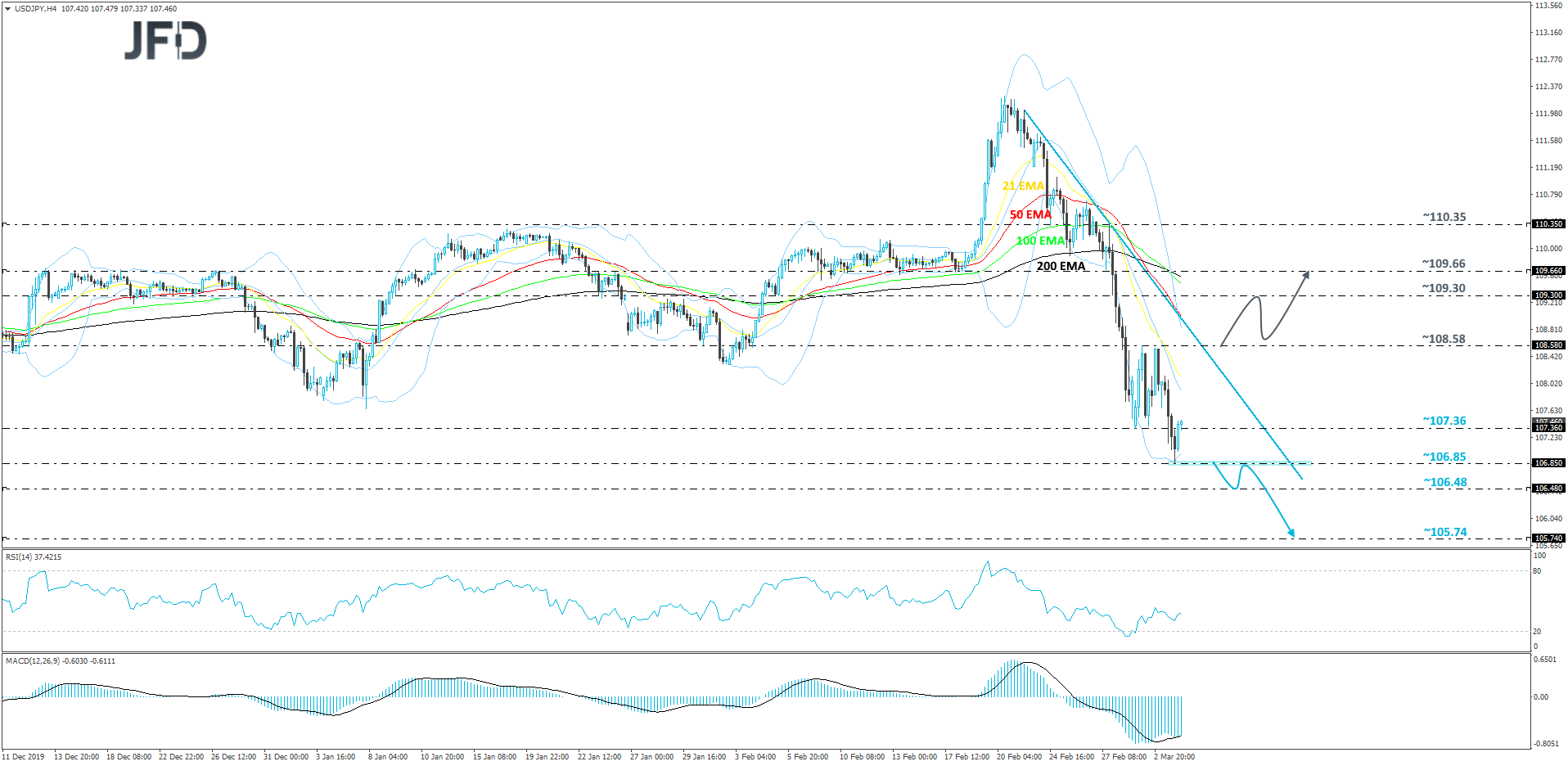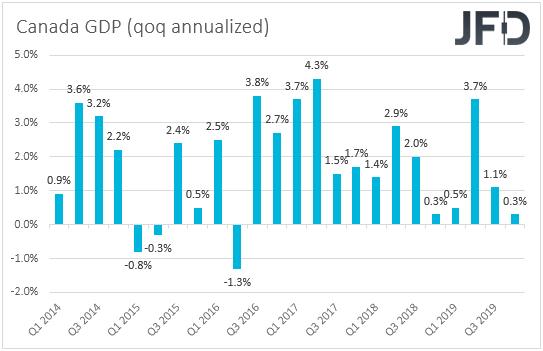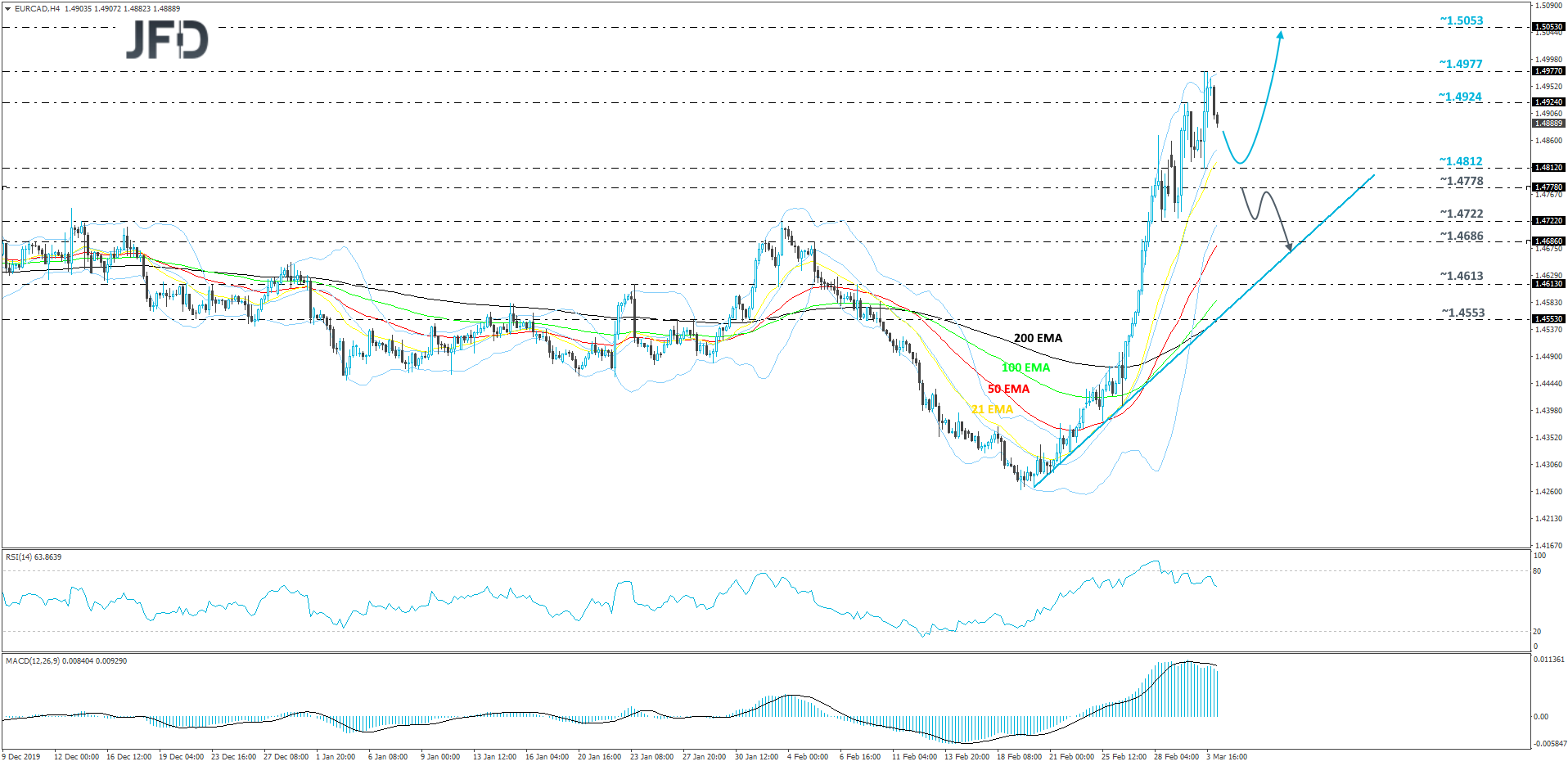Yesterday, the FOMC decided to cut interest rates by 50bps, the first emergency move outside a scheduled meeting since the 2008 financial crisis, in an attempt to safeguard the world’s largest economy from the impact of the coronavirus. However, markets did not cheer the move for long, with Wall Street indices closing the US session nearly 3% down. Today, it’s the turn of the BoC, which is also expected to cut rates, but the big question is by how much.
FED DELIVERS THE FIRST EMERGENCY CUT SINCE THE 2008 CRISIS
The dollar continued trading lower against all but one of the other G10 currencies on Tuesday and during the Asian morning Friday. It lost the most ground against SEK, AUD and JPY, while it eked out some gains only versus CAD.

The strengthening of the safe-haven yen and the commodity-linked currencies does not paint a clear picture with regards to the broader market sentiment and thus, we will have to turn our gaze once again to the equity world. Major EU indices closed in positive territory for the second consecutive day, perhaps on expectations over a coordinated policy action by major central banks to avert a global recession due to the economic effects of the fast-spreading coronavirus. That said, sentiment took a 180-deegree spin during the US session, with all three of Wall Street’s major indices tumbling nearly 3%. During the Asian morning today, risk aversion eased, with Japan’s Nikkei and Hong Kong’s Hang Seng trading virtually unchanged, while China’s Shanghai Composite and South Korea’s KOSPI gained 0.63% and 2.24% respectively.

Yesterday, the FOMC decided to cut the federal funds rate by 50bps, the first emergency move outside a scheduled meeting since the 2008 financial crisis, in an attempt to safeguard the world’s largest economy from the impact of the coronavirus. The Fed became the second in line central bank to act following the outbreak, after the RBA’s decision to cut by 25bps to a new record low of +0.50% during the Asian morning Tuesday. The dollar slid at the time of the Fed’s announcement, while equity markets gained somewhat. However, the gains were short-lived with cash indices surrendering those gains and trading even lower.
Bearing in mind that a double cut by the Fed was fully priced in at the upcoming meeting, in two weeks, the only surprise was the timing. Thus, the aftermath decline may have been a “sell the fact” reaction. It could also be that investors remained unconvinced that this double cut will be enough to tackle the impact of the virus on the world’s largest economy. Although at a press conference following the decision, Fed Chair Powell said that the current policy stance is appropriate, investors expect more easing to come. According to the Fed funds futures, they still expect a quarter-point decrease to be delivered at the upcoming gathering, while they see rates being 50bps lower in June. This means that officials are expected to deliver one quarter-point cut at the next meeting and another one in June, or to proceed directly with another double cut in June, as they may prefer to wait for the current move to be absorbed by the economy.

What may have also come as a disappointment to the financial world may have been the communiqué of the G7 finance ministers and central bank governors, who following a conference call yesterday, fell short of calling for specific actions to battle the coronavirus’s economic effects. In the after-call statement they just reaffirmed their “commitment to use all appropriate policy tools to achieve strong, sustainable growth and safeguard against downside risks.”
As for our view, it has not changed, even after the Fed’s double cut outside a regularly scheduled gathering. We repeat that it may be naïve to assume that rate cuts will be enough to revive global growth. Yesterday, both infected cases and deaths from the coronavirus returned into acceleration mode, confirming our view that the worst is not behind us yet. With the virus now spreading much faster outside China than within, and with no vaccine on the horizon, predicting when it will be contained, and how large the effects will be, appears to be a hard task. We already got a taste of how the outbreak has impacted the service sector of the Chinese economy, with the Caixin PMI tumbling to a record low of 26.5 from 51.8 in January. If this coordinated easing effort fails to stimulate decently the global economy, panic may return into the financial world, leading to another slide in equities and other risk-linked assets as investors could start seeking shelter in safe havens again.

USD/JPY – TECHNICAL OUTLOOK
USD/JPY continues to drift lower, trading below a short-term downside resistance line taken from the high of February 21st. Yesterday, the pair found some support near the 106.85 hurdle and rebounded somewhat. Although we may see a bit more correction to the upside, as long as the rate remains below that downside line, the bearish pressure could stay there for a while. However, in order to get comfortable with further declines, we would like to see a drop below the above-discussed hurdle first.
If the pair moves below the 106.85 area, this will confirm a forthcoming lower low and could clear the path to the 106.48 zone, which is the lowest point of October 2019. Even if USD/JPY stalls around there, or rebounds from that level, a failure to break the previously-mentioned downside line could cause another round of selling. A further drop and a break of the 106.48 obstacle may send the rate lower, potentially targeting the 105.74 mark, which is the lowest point of September 2019.
Alternatively, if the rate does travel above the aforementioned downside line and pushes above the 108.58 barrier, marked by the current highest point of March, this could give a chance for more bulls to join in. That’s when we will start aiming for the 109.30 hurdle, a break of which may open the door to the 109.66 zone, which is near the low of February 18th and near the high of February 28th.

WILL THE BOC MIMIC THE FOMC AND DELIVER A DOUBLE CUT?
As for today, the central bank torch will be passed to the Bank of Canada. At its latest gathering, the Bank kept interest rates unchanged, but the statement had a dovish flavor, suggesting that officials have opened the door to a rate cut. They removed the part saying that it is appropriate to maintain the current level of interest rates and instead noted that “In determining the future path for the Bank's policy interest rate, Governing Council will be watching closely to see if the recent slowdown in growth is more persistent than forecast”.
Since then, most data have been on the bright side, with the unemployment rate ticking down to 5.5% from 5.6%, and inflation accelerating by more than anticipated. That said, Friday’s GDP data showed that the economy slowed to an annualized rate of +0.3% qoq in Q4 from a downwardly revised +1.1% in Q3. At this point, we need to say that, although this Bank was not expected to push the cut button at this gathering on Monday morning, today they are widely anticipated to do so.

Thus, the question now may not be whether they will cut or not, but whether they will cut by 25bps or 50bps. Bearing in mind that a quarter-point cut is largely expected, we don’t expect the Loonie to slide much if this is the case. After all, it was yesterday’s main loser, which suggests that a cut may be already priced in. For the currency to fall instantly, a 25bps decrease may have to be accompanied by a very dovish language, pointing to more cuts in the months to come, or the Bank will have to mimic the FOMC and deliver a double cut.
In any case, whatever the outcome is, we see the path of least resistance for the Loonie to be to the downside. As we already noted, we don’t expect rate cuts to be enough to revive economic growth. With the virus still spreading fast, restrictive measures are likely to stay in place for longer, or even get tightened further, which may prevent consumers from getting out of their homes and start spending. Thus, another round of risk aversion may result in lower oil prices and thereby a lower Loonie. Don’t forget that Canada is the world’s fourth largest oil producing nation.
EUR/CAD – TECHNICAL OUTLOOK
Last week, EUR/CAD sharply accelerated to the upside and continued to drift in that direction this week as well. But looking at our oscillators, the RSI and the MACD on the 4-hour chart, we are starting to notice that the buying momentum is slowly fading away and we may see a bit of correction lower. That said, given that the Canadian dollar is still on the weaker side against its major counterparts, EUR/CAD may resume its uprise and go for another higher high. For now, we will stay cautiously-bullish.
A small decline could bring the rate closer to the 1.4812 zone, which is yesterday’s low. Around there, the pair might also test the 21 EMA on the 4-hour chart and if this territory provides support, EUR/CAD could rebound and move higher again. If it manages to overcome the 1.4924 hurdle, or the 1.4977 barrier, marked by the current high of March, this may attract more buyers into the game, who might help the pair to move to the 1.5053 level. That area is marked by the high of June 24th, 2019.
On the other hand, if the rate slides below the aforementioned 1.4812 hurdle and falls below the 1.4778 territory, which is an intraday swing high of March 2nd, that may lead EUR/CAD to a deeper correction. The pair could then test the 1.4722 zone, which if breaks may open the door for a move to the 1.4686 level, marked by the high of February 5th, or the short-term upside support line drawn from the low of February 20th.

AS FOR THE REST OF TODAY’S EVENTS
We get the Eurozone, the UK and the US final Markit services and composite PMIs for February and are expected to confirm their initial estimates. Again, market participants may pay more attention to the US ISM non-manufacturing PMI, which is expected to have declined to 54.9 from 55.5. Such a slide is unlikely to raise concerns with regards to the performance of the US economy, but a negative surprise, perhaps below 50, could most probably do.
From the US, we also get the ADP report for February. The forecast suggests that the private sector has gained 191k jobs, less than January’s 291k. Something like that may raise speculation that the NFPs, due out on Friday, may also come below their January print. Having said that though, we repeat for the umpteenth time that, although the ADP is the only major gauge we have for the NFPs, it is far from a reliable predictor. The correlation between the two time-series at the time of the release (no revisions are taken into account) has fallen in recent years. Taking data from back in January 2011, that correlation stands at 0.41.

With regards to the energy market, we get the EIA (Energy Information Administration) report on crude oil inventories for last week. Expectations are for a 2.644mn bpd build up, following a small increase of 0.452mn bps the week before. That said, bearing in mind that the API (American Petroleum Institute) revealed a 1.690mn bpd inventory build, we see the risks surrounding the EIA forecast as tilted somewhat to the downside.
As for tonight, during the Asian morning Thursday, we get Australia’s trade balance for January. Expectations are for the nation’s surplus to have narrowed to AUD 4.800bn from AUD 5.223bn in December.
We also have three speakers on our agenda: Today, we will get to hear from BoE MPC member Ben Broadbent and ECB Governing Council Member Jens Weidmann, while tonight, St. Louis Fed President James Bullard will step up to the rostrum.
